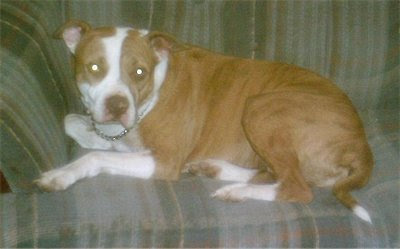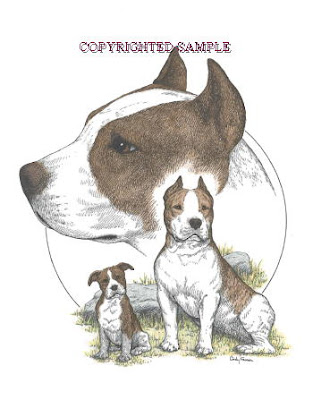PIT BULL INFORMATION
BY THE POSITIVE PITBULL AWARENESS SOCIETY
NOTE: Throughout discussions of the Pit Bull breed, you will notice two words repeated over and over again: Responsible Ownership. With media hysteria and BSL (Breed specific legislation), we good owners, find ourselves endlessly having to defend our breed. Every bad story and headline damage our dogs even further. Irresponsible and ignorant owners have done almost as much damage to these dogs as dogfighters have. The Pit Bull is an exceptional breed that requires exceptional dedication and ownership. This page may seem to paint a grim picture of Pit Bull ownership, but the breed’s very survival depends on new owners knowing what they are getting into, and ALL owners being responsible and protecting the breed’s reputation.
AGGRESSION
In the following sections I will discuss aggression in the American Pit Bull Terrier. It is VERY important to note that, in dogs, and especially with this particular breed, aggression toward humans (called human aggression) is a COMPLETELY separate trait from aggression toward dogs (dog aggression) and/or other animals (animal aggression). While a dog may be both human and animal aggressive, the presence of one kind of aggression DOES NOT mandate or exclude the presence of the other.
TEMPERAMENT, WHAT IS IT?
Simply put, temperament is those behavioral traits and mental attitudes shared by canines and combined with the special characteristics proper to a certain dog breed. Newfoundlands for example, like water and love children, that is part of the breed’s temperament. A Newfoundland that hates to swim or growls at a child is showing improper temperament for the breed. When a person talks about the temperament of their chosen breed, they are describing those traits which most good examples of the breed will have, rather than describing a specific dog. A dog who posses all or most of the characteristics expected for their breed is said to have a proper temperament. This is why it is very important to know about your chosen breed’s temperament and research its specific traits, preferably before you commit to a dog. You may find out that even though you like the “look” of a certain breed, the temperament is not for you.
A WORD ABOUT BREED HISTORY
Much of a dog’s temperament relates to its breed history and genetic inheritance. I won’t go too deep into the history of the Pit Bull as there are many good books and websites that cover the origin and history of the breed. It is common knowledge however, that the Pit Bull breed was developed for blood sports: Bull baiting, bear baiting, and later, dogfighting. What is not common knowledge is that in the days of organized dogfighting, the handlers of the combatants were habitually IN THE PIT with the dogs for the duration of the fight. They were required to pick up and separate the dogs several times while the dogs were in full fight frenzy. Before the fight, the handlers were required to wash each other’s dogs, and after the fight, the badly injured dogs were often treated at ringside by strangers. Any dog that attacked or bit a handler (even if it was the other dog’s handler) or anyone else at any time was culled, often on the spot, and would never have been bred.
SO, WHAT IS THE PROPER PIT BULL TEMPERAMENT?
As with all breeds, the Pit Bull has positive and negative traits in their temperament. Their breed history has led to a dog unlike any other in the history of purebred dogs. What can you expect from an APBT? First and foremost, memorize the following: THE GOLDEN RULE OF PIT BULL OWNERSHIP – NEVER TRUST YOUR PIT BULL NOT TO FIGHT! This breed is descended from pit dogs one way or another, and, given the right circumstances, most Pit Bulls will fight and against any other breed, they will win (you really don’t want to see that!). Scared yet? You should be. Remember, as the owner of a Pit Bull everything you or your dog do will affect all members of the breed and their families. Pit Bull owners have to be extra vigilant 24/7, period. You need to be receptive, have strong leadership, and be able to read canine body language to recognize signs of tension between housemates. You need to be prepared to separate the dogs if tensions develop. You need to know when your dog may become aggressive and you need to have control of your dog under any circumstances. Sound like a lot of work and hassle? It is. So, what’s the payoff? The payoff is: A well-raised pit bull of proper temperament is the most loyal and loving dog in the world, bar none. This is a dog that truly LOVES people, especially children. Pits are notorious clowns, and will Always make you laugh, even in spite of yourself. They are intelligent, and will often “invent” games to keep themselves amused. They seem to subsist on love and attention, and will do almost anything for a little special “loves n hugs” time. They tolerate the rough play of children, loving every minute of it, and, although poor “guard dogs” for property, they will willingly give their lives to save the people they love. Thousands of responsible owners have dedicated themselves to this breed for it’s positive traits and willingly deal with the negatives.
TO SUMMARIZE THE PROPER PIT BULL TEMPERAMENT
1. Pit Bulls are often dog-aggressive to one extent or another (this often shows up at or near sexual maturity). A dog that was previously non-dog aggressive may “turn-on” and suddenly doesn’t like other dogs of the same sex, or, for that matter, any dogs at all, even housemates they have been raised with. Adult Pit Bulls should NEVER be left alone with other dogs and require proper supervision. 2. Pit Bulls may exhibit intense “prey drive”, leading them to “stalk” small animals such as cats, rats, chickens, livestock, or other pets. 3. Pit Bulls are precocious and incomparable escape artists, who will often seem to squirt right out of a supposedly secure yard or enclosure. When coupled with # 1 and # 2, you can see why a responsible Pit Bull owner is a vigilant pit bull owner.4. Pit bulls are intelligent, and most enjoy training, if it is done properly. This makes them excellent prospects for dog sports such as agility, obedience, weight pull, and Frisbee competitions. .5. Pit Bulls tend to LOVE people. All people. This makes them a poor choice for a “guardian breed”. Most of them are simply too friendly to protect a house against strangers. A Pit Bull that shows unprovoked human aggression (puppy play nips do NOT count) is showing BAD temperament and in most cases should be put to sleep. Such a dog should obviously NEVER be bred under any circumstances. The breeding of dogs with bad temperaments is one of the largest problems the breed faces today and fuels the fire of breed specific legislation.6. Pit bulls tend to be very “soft” with their family, meaning that they are eager to please their humans. They should not have to be “shown who’s boss”, but will thrive under “positive leadership”. A Pit Bull of proper temperament is a devoted and loving family member, inspiring immense loyalty to the breed. You will often hear a Pit Bull’s owner tell you that after owning one, they will never own any other breed.
PITBULL APPEARANCE
Built for performance, the pit bull is a medium sized, very muscular, short coated breed. The head is bricklike, the jaws strong and wide, the ears may be cropped or not (I prefer uncropped dogs for several reasons). The body is typically very strong, with a deep chest, powerful and proportionate hind end and solid legs. The overall impression should be of power and athleticism. This is not a dog for couch potatoes, as it requires A LOT of training and exercise. With this breed it is important to remember to exercise both the dog’s body and mind. Remember, a tired pit bull is a happy pit bull and a bored pit bull is NOT a good thing! They will find some very inventive ways to entertain themselves that the owner may not like (often involving the garbage can, kitchen counter and cabinets, feather pillows, dirty laundry and various items of furniture). Remember also, that this is a VERY enthusiastic breed that may very well overwhelm young children or older people with it’s affection. This breed needs to be taught to sit and greet people calmly as it’s natural inclination will probably be to climb into their lap, put a paw on each of their shoulders, and attempt to wipe their face off with it’s tongue. Attempts to convince a full grown pit bull that it is too big to be a “lap dog” will, more often than not, fall on deaf ears if it was not taught “manners” as a puppy. Do not allow your puppy to do anything you don’t want your adult dog to do (eg climb on the couch, sleep in the bed, invade your lap, etc.).
FCI not recognized, Origin: England, Ireland, USA, Group Mastiff. Height: 18-24 in, Weight: 30-60 pounds Grooming: Low, Shedding: Medium, Coat: Smooth, glossy. Color:Any color except for merle. Ease of training: High, Energy level: High, Span of life: 11-14 years |
Breed: From the time of the breed formation to the present day American Pit Bull remains versatile, easily trained dog that can easily cope with the pastoral, hunting, guarding and weight-pulling work as well as with the role of the dog-nanny, willing to come into play with the children, guarding and protecting them.
The origin of American Pit Bulls is deeply rooted in history. The first references and evidences, that in many parts of continental Europe and Britain, people were breeding and using these dogs, are from about 2300 BC, they were found in the tombs of Abyssinia and Tibet.
In the writings of Grazii Falliskus, dated approximately 200 year BC, there is a mentioning of dogs with this type of constitution, brought from Britain, who were stronger and therefore more victorious than the local Roman dog breeds, while acting in the Roman arenas.
There are written evidences that between 12 and 18 centuries in England and continental Europe the fights between dogs and bulls (or bears) was a very popular way of entertainment. On the engravings of 15-18 centuries there are pictured some dogs of the same type as the modern American Staffordshire Terriers and Pit Bull Terriers - involved in dog fighting and hunting.
Based on existing historical documents, we can conclude that the Pit Bulls had been in America before the War of Liberation (1774). It is known for sure that they were brought by the immigrants from European countries: first of all from Spain, Sicily, England and Holland. The biggest import of Pit Bulls happened immediately after 1845, when a large number of immigrants from Ireland came to America.































































































































































































































































































































































